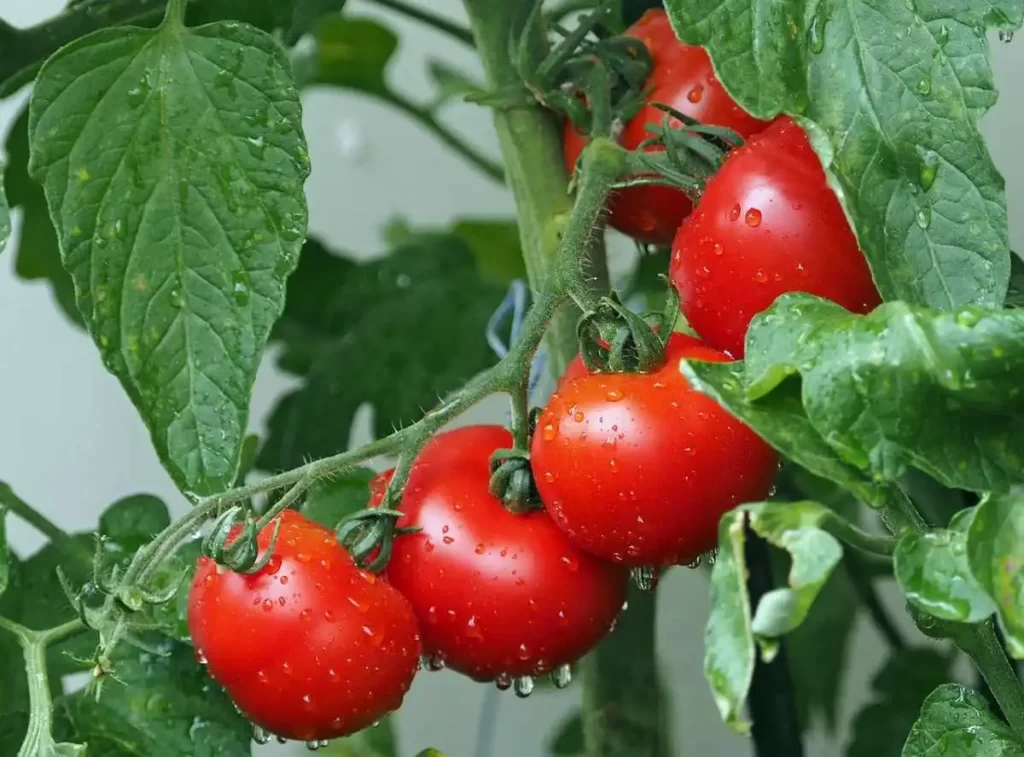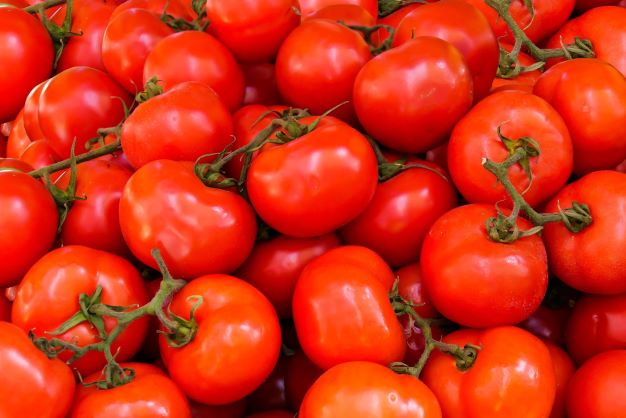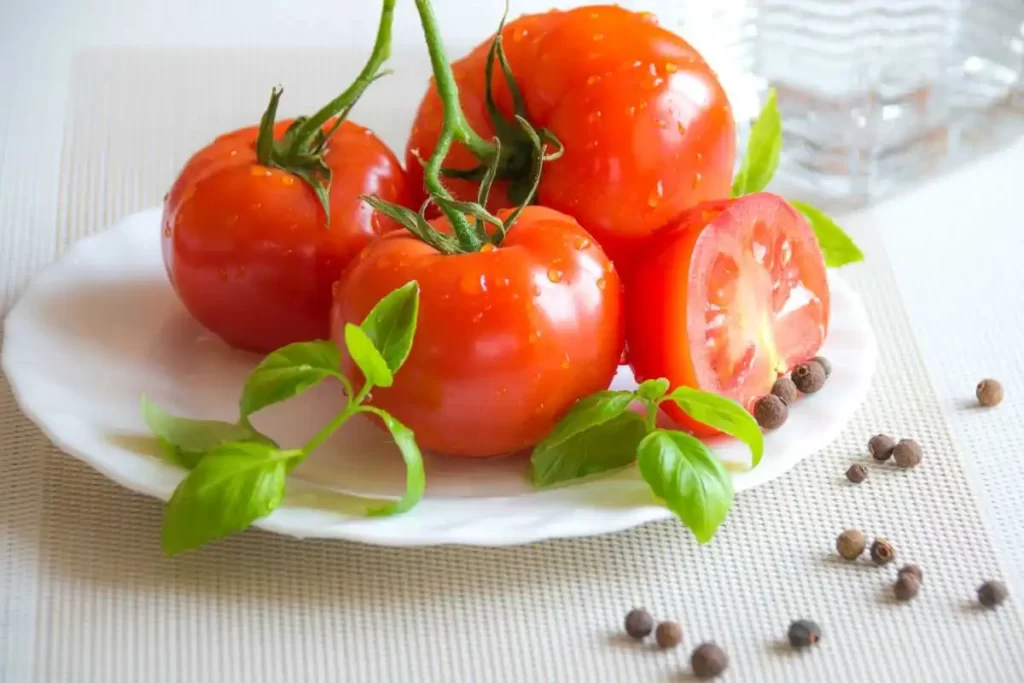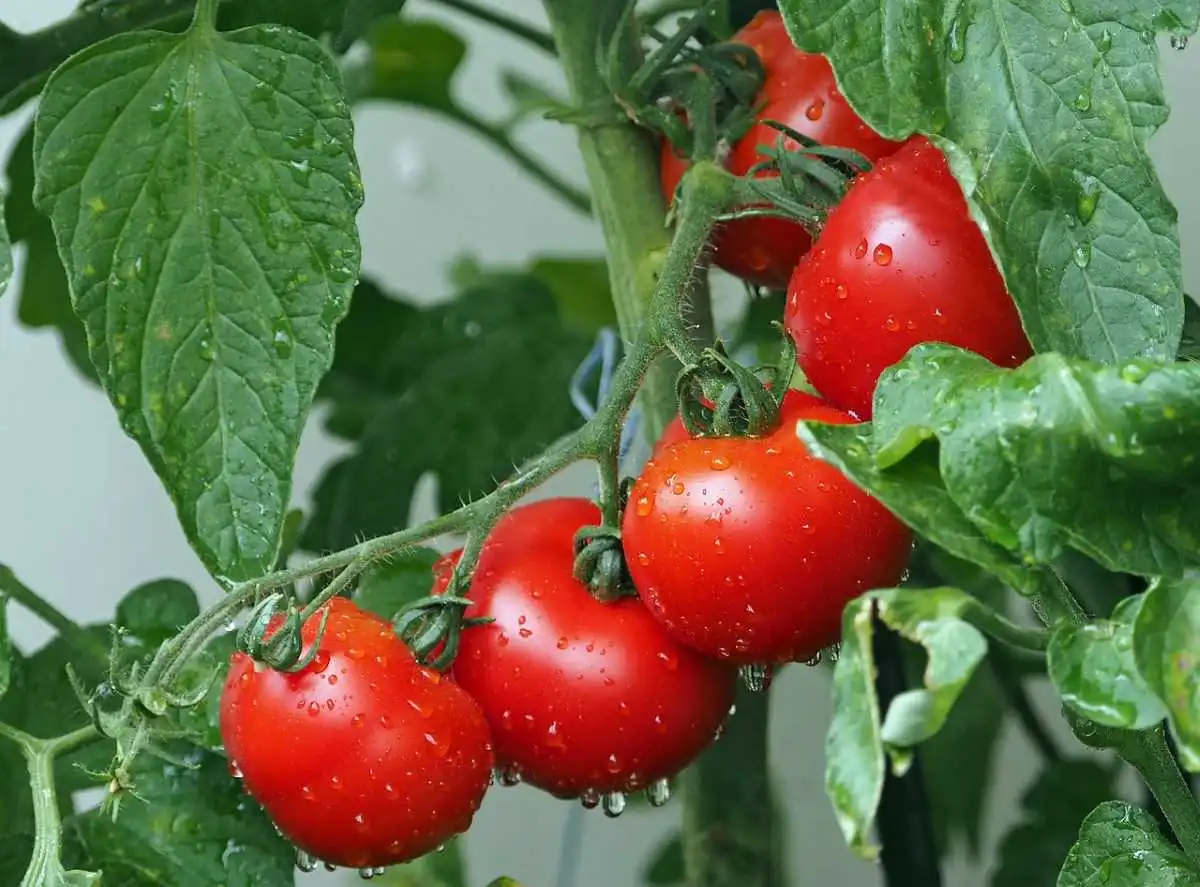Tomatoes are not just a staple in countless recipes; they’re also a nutritional powerhouse packed with an array of health benefits.
Whether consumed raw, cooked, or in sauces, these vibrant fruits (often mistaken for vegetables) are a versatile addition to your diet.
In this comprehensive guide, we’ll delve deep into the world of tomatoes, exploring their nutritional value, health benefits, culinary uses, and delectable recipes.

Table of Contents
The Tomato: A Short Introduction
Native to western South America, tomatoes, scientifically known as Solanum lycopersicum, belong to the nightshade family, Solanaceae.
Initially, tomatoes were considered ornamental plants until their culinary potential was discovered.
Over time, they’ve become a staple ingredient in various cuisines worldwide, from Italian pasta sauces to Mexican salsas.
Also Read:
- Taro Stem: Side Effects, Nutrition Facts, Health Benefits.
- Broccoli Rabe: Side Effects, Nutrition, Benefits, Recipes & All.
Nutritional Profile of Tomatoes

Tomatoes are a versatile and delicious fruit (yes, technically a fruit!) that are packed with nutrients.
Here’s a breakdown of their nutritional value per 100 grams (about 3.5 ounces):
| Nutrient | Amount | % Daily Value (DV) |
|---|---|---|
| Calories | 18 | 1% |
| Fat | 0.2 g | 0% |
| Saturated fat | 0.1 g | 0% |
| Cholesterol | 0 mg | 0% |
| Sodium | 6 mg | 0% |
| Potassium | 291 mg | 8% |
| Total carbohydrates | 4.8 g | 2% |
| Fiber | 1.5 g | 6% |
| Sugar | 3.2 g | 4% |
| Protein | 1.1 g | 2% |
| Vitamin A | 47% DV | |
| Vitamin C | 29% DV | |
| Vitamin K | 8% DV | |
| Folate | 4% DV | |
| Manganese | 7% DV | |
| Magnesium | 5% DV | |
| Copper | 4% DV | |
| Biotin | 4% DV |
1. Vitamins and Minerals in Tomatoes
Tomatoes are a treasure trove of essential vitamins and minerals crucial for overall well-being:
- Vitamin C: One medium-sized tomato can provide about 28% of the daily recommended intake of vitamin C. This potent antioxidant supports the immune system, aids in collagen formation for healthy skin, and helps in iron absorption.
- Vitamin K: Tomatoes contribute to your vitamin K intake, vital for blood clotting and bone health. Just a cup of chopped tomatoes can offer around 9% of the daily requirement of this nutrient.
- Potassium: A medium-sized tomato contains approximately 292 milligrams of potassium, contributing to maintaining proper fluid balance, nerve function, and muscle control. Potassium also helps in regulating blood pressure.
- Folate (Vitamin B9): This B-vitamin is crucial for pregnant women, aiding in proper fetal development. Tomatoes contain small amounts of folate, providing around 5% of the daily recommended intake per cup.
- Vitamin A: Tomatoes contain beta-carotene, a precursor to vitamin A, which plays a role in maintaining healthy vision, skin, and a robust immune system.
2. Phytochemicals and Antioxidants in Tomatoes
- Lycopene: Considered one of the most potent antioxidants found in tomatoes, lycopene gives tomatoes their characteristic red color. Studies suggest that lycopene may help reduce the risk of chronic diseases, including certain types of cancer and heart disease.
- Beta-carotene and Other Carotenoids: Besides lycopene, tomatoes contain other carotenoids like beta-carotene, lutein, and zeaxanthin, known for their beneficial effects on eye health and reducing the risk of age-related macular degeneration.
How Cooking Affects Tomato Nutrients
Interestingly, while cooking tomatoes may reduce the vitamin C content slightly, it significantly enhances the availability of lycopene, making it easier for the body to absorb.
Heat processing breaks down the cell walls of the tomato, releasing more lycopene and making it more bioavailable.
To maximize the nutritional benefits, a combination of both raw and cooked tomatoes in your diet can be advantageous, ensuring a good intake of both vitamin C and lycopene.
Also Read:
- What Does Beet Juice Taste Like? Recipe, Benefits, Risks & All.
- What Does Turnip Taste Like? Benefits, Side Effects & More.
Health Benefits of Tomatoes
Consuming tomatoes regularly can offer numerous health benefits:
1. Heart Health
The combination of vitamins, minerals, and antioxidants in tomatoes contributes to heart health in several ways:
- Lycopene for Heart Health: Lycopene, a powerful antioxidant in tomatoes, has been associated with reducing the risk of heart disease. It helps lower levels of LDL cholesterol (the “bad” cholesterol) and reduces inflammation, thus supporting cardiovascular health.
- Potassium Content: Tomatoes are a good source of potassium, which helps regulate blood pressure. Adequate potassium intake is linked to lower blood pressure levels and reduced risk of stroke.
2. Cancer Prevention
Tomatoes possess compounds that have shown promising effects in reducing the risk of certain cancers:
- Lycopene’s Anticancer Properties: Research suggests that lycopene, along with other antioxidants in tomatoes, may help reduce the risk of certain cancers, especially prostate, lung, and stomach cancers. Lycopene’s ability to neutralize harmful free radicals is thought to play a role in preventing cell damage that could lead to cancer.
- Antioxidants and Cancer Prevention: Beyond lycopene, the presence of various antioxidants in tomatoes, such as beta-carotene and vitamin C, contributes to their cancer-fighting properties by combating oxidative stress and cell damage.
3. Skin Health
Tomatoes can promote healthy skin due to their nutrient content and antioxidant properties:
- Protection Against UV Damage: The antioxidants, including lycopene and beta-carotene, found in tomatoes help protect the skin from UV damage, reducing the risk of sunburn and supporting overall skin health.
- Collagen Production: Vitamin C in tomatoes plays a crucial role in collagen synthesis, aiding in maintaining skin elasticity and preventing premature aging.
4. Improved Vision
The nutrients present in tomatoes support good vision and eye health:
- Vitamin A and Beta-Carotene: Both vitamin A and beta-carotene are essential for eye health. They help maintain proper vision, particularly in low-light conditions, and reduce the risk of age-related macular degeneration.
5. Weight Management
Tomatoes can be beneficial for those aiming for weight management:
- Low in Calories, High in Fiber: Tomatoes are low in calories and high in fiber, making them a filling and satisfying addition to meals. High fiber content aids digestion, promotes a feeling of fullness, and can assist in weight management by curbing excessive food intake.
Types of Tomatoes

Tomatoes come in various shapes, sizes, and colors. Some common types include:
1. Cherry Tomatoes
Cherry tomatoes are small, round, and typically sweet in flavor. They come in various colors, including red, yellow, and even purple.
These bite-sized tomatoes are perfect for salads, snacking, or adding vibrant color to dishes due to their attractive appearance.
2. Roma Tomatoes (Plum Tomatoes)
Roma tomatoes are known for their elongated, oval shape and thick, meaty flesh with fewer seeds and juice.
They’re ideal for making sauces, pastes, and canning due to their low moisture content.
Their robust flavor enhances sauces without making them excessively watery.
3. Beefsteak Tomatoes
Beefsteak tomatoes are large, round, and often hefty. They’re juicy and have a meaty texture, making them great for slicing and adding to sandwiches, burgers, or enjoying fresh in salads.
Their size and rich taste make them a popular choice for substantial dishes.
4. Heirloom Tomatoes
Heirloom tomatoes come in various shapes, sizes, and colors, and they’re treasured for their unique flavors and textures.
These non-hybrid tomatoes are often passed down through generations, offering diverse tastes—from sweet to tangy to complex, earthy flavors.
They’re excellent for eating fresh, adding complexity to salads or sandwiches, and even as a stand-alone snack.
5. Grape Tomatoes
Grape tomatoes are small, oblong-shaped tomatoes that resemble grapes in appearance. They’re sweet, firm, and less juicy compared to cherry tomatoes.
Grape tomatoes are fantastic for snacking, roasting, or adding to pasta dishes and salads.
6. Green Tomatoes
Green tomatoes are unripe tomatoes that remain green even when fully grown. They have a tart flavor and firm texture, making them suitable for frying or pickling.
They can add a unique twist to dishes, especially when used in fried green tomato recipes or relishes.
7. Campari Tomatoes
Campari tomatoes are slightly larger than cherry tomatoes and are known for their deep red color and exceptional sweetness.
They have a rich flavor profile and are perfect for salads, garnishes, or eating whole as a snack.
Incorporating Tomatoes into Your Diet
Let’s explore how to incorporate tomatoes into your diet:
1. Raw Consumption
- Salads: Tomatoes add freshness, color, and a juicy burst of flavor to salads. Combine them with leafy greens, cucumbers, bell peppers, and your choice of dressing for a nutritious salad.
- Snacking: Cherry or grape tomatoes make a convenient and healthy snack option. Pair them with hummus or cheese for added taste and nutrients.
2. Cooking
- Sauces: Tomatoes form the base for a multitude of sauces, including marinara, salsa, or curry sauces. Use them in pasta dishes, pizzas, or as a flavorful topping for grilled meats.
- Roasting: Roasting tomatoes intensifies their flavor and sweetness. Toss them with olive oil, garlic, and herbs before roasting for a delicious side dish or to top bruschetta.
- Grilling: Grilled tomatoes make a fantastic accompaniment to grilled meats or vegetables. Drizzle with balsamic glaze for added depth of flavor.
3. Soups and Stews
- Tomato Soup: Blend ripe tomatoes with onions, garlic, and herbs for a comforting and nutritious soup. Pair it with a grilled cheese sandwich for a classic combination.
- Stews and Curries: Add chopped tomatoes to stews, curries, or chili to enhance the flavor and provide a dose of freshness.
4. Sandwiches and Wraps
- Sandwiches: Sliced tomatoes complement sandwiches, providing juiciness and a hint of acidity. Layer them in sandwiches, burgers, or wraps for added texture and taste.
- Bruschetta and Crostini: Top toasted bread slices with a mixture of diced tomatoes, garlic, basil, and olive oil for a delightful appetizer or snack.
5. Preserving
- Canning and Preserving: Preserve the harvest by canning tomatoes to use in sauces, soups, or stews throughout the year. Canned tomatoes retain their flavor and nutrients for future culinary adventures.
Tomato Recipes

Here are a few tantalizing recipes showcasing the versatility of tomatoes:
1. Caprese Salad
Ingredients:
- Fresh tomatoes (sliced)
- Fresh mozzarella cheese (sliced)
- Fresh basil leaves
- Extra virgin olive oil
- Balsamic glaze
- Salt and pepper to taste
Instructions:
- Arrange alternating slices of tomatoes and mozzarella on a plate.
- Place basil leaves between the slices.
- Drizzle olive oil and balsamic glaze over the salad.
- Sprinkle with salt and pepper. Serve chilled.
2. Homemade Tomato Pasta Sauce
Ingredients:
- Fresh tomatoes (peeled and chopped)
- Garlic cloves (minced)
- Onion (finely chopped)
- Olive oil
- Fresh basil leaves
- Salt and pepper to taste
Instructions:
- Heat olive oil in a pan and sauté minced garlic and chopped onion until soft.
- Add chopped tomatoes and cook until they break down.
- Season with salt and pepper, and add torn basil leaves.
- Simmer the sauce until it reaches desired consistency. Serve over pasta.
3. Oven-Roasted Cherry Tomatoes
Ingredients:
- Cherry tomatoes
- Olive oil
- Garlic powder
- Dried oregano
- Salt and pepper
Instructions:
- Preheat oven to 375°F (190°C).
- Toss cherry tomatoes with olive oil, garlic powder, oregano, salt, and pepper.
- Place them on a baking sheet and roast for 20-25 minutes until slightly caramelized.
- Serve as a side dish or atop crusty bread slices.
Tomato Side Effects
Tomatoes are generally considered safe for most people, but some individuals may experience certain side effects or considerations:
1. Allergic Reactions:
- Tomato Allergy: Allergic reactions to tomatoes are uncommon but can occur. Symptoms may include itching, swelling of the face or lips, hives, or digestive issues like stomach pain. In severe cases, it could lead to anaphylaxis, a life-threatening allergic reaction.
2. Gastrointestinal Issues:
- Acid Reflux or Heartburn: Tomatoes are acidic and may exacerbate symptoms in individuals with acid reflux or heartburn. This is due to the presence of citric and malic acids, which can trigger reflux symptoms in some people.
3. Sensitivity to Nightshades:
- Nightshade Sensitivity: Tomatoes belong to the nightshade family, and individuals sensitive to nightshade vegetables might experience adverse reactions. Symptoms could include joint pain, digestive issues, or inflammation in susceptible individuals.
4. Kidney Stones Risk:
- Oxalate Content: Tomatoes contain oxalates, which can contribute to the formation of kidney stones in individuals prone to them. People with a history of kidney stones might need to moderate their tomato intake.
5. Histamine Content:
- Histamine Release: Tomatoes contain histamines that can trigger allergic-like reactions in some individuals, leading to symptoms such as headaches, skin rashes, or nasal congestion, particularly in those with histamine intolerance.
6. Interaction with Medications:
- Interference with Medications: Tomatoes contain compounds that might interact with certain medications. For instance, they contain vitamin K, which can interfere with blood-thinning medications like Warfarin.
Conclusion
Tomatoes are more than just a flavorful addition to meals; they’re a nutritional powerhouse loaded with vitamins, minerals, and antioxidants.
From supporting heart health to promoting radiant skin, the benefits of tomatoes are extensive.
Whether eaten raw, cooked or in various recipes, incorporating tomatoes into your diet can contribute to a healthier lifestyle.
So, explore the diverse world of tomatoes and savor their goodness in your culinary creations!
FAQs:
1. How do I choose ripe tomatoes at the grocery store?
When selecting tomatoes, consider the following tips:
- Look for tomatoes that are brightly colored and free from bruises or blemishes.
- They should feel firm yet slightly yielding to gentle pressure.
- A ripe tomato should have a pleasant, slightly sweet aroma at the stem end.
2. Should tomatoes be stored in the refrigerator or at room temperature?
Tomatoes are best stored at room temperature to maintain their flavor and texture. Refrigeration can diminish their taste and cause a mealy texture. If fully ripe and you won’t be using them immediately, place them in a cool spot away from direct sunlight.
3. Are there any benefits to cooking tomatoes versus eating them raw?
Cooking tomatoes can enhance their nutritional benefits in some aspects. While heat diminishes vitamin C content slightly, it increases the availability of lycopene, a powerful antioxidant. Consuming cooked tomatoes may actually make it easier for your body to absorb certain nutrients.
4. Can I freeze tomatoes for later use?
Yes, tomatoes can be frozen for future use. Wash and dry them thoroughly, then slice or dice as needed. Place the tomatoes in airtight containers or freezer bags, removing excess air. Frozen tomatoes are suitable for use in cooked dishes like sauces, stews, or soups, but their texture might change when thawed.
5. Are green tomatoes safe to eat?
Unripe green tomatoes are safe to eat but may have a tart or slightly bitter taste compared to ripe ones. They’re often used in cooking, particularly fried green tomato recipes. However, avoid eating tomatoes that are green due to being underripe as they might cause stomach discomfort.
6. Are there any varieties of tomatoes that are better for specific dishes?
Yes, different tomato varieties have distinct characteristics that make them suitable for various dishes:
- Roma or plum tomatoes are excellent for sauces and pastes due to their low moisture content and dense flesh.
- Cherry or grape tomatoes work well in salads, as snacks, or for roasting due to their small size and sweet flavor.
- Beefsteak tomatoes are ideal for slicing and using in sandwiches or burgers because of their large size and meaty texture.
7. Are there any allergic reactions associated with tomatoes?
While rare, some individuals may experience allergic reactions to tomatoes. Symptoms can range from mild to severe and might include itching, swelling, hives, or gastrointestinal discomfort. Consult a healthcare professional if you suspect a tomato allergy.
8. Can tomatoes be part of a low-carb or ketogenic diet?
Yes, tomatoes can be included in moderate amounts in low-carb or ketogenic diets. While they contain carbohydrates, they are relatively low in net carbs, making them a suitable choice for those following these dietary approaches. However, individuals should consider their total carbohydrate intake from all sources to stay within their dietary goals.
9. Are there any safety concerns related to tomato consumption?
Tomatoes are generally safe to eat for most people. However, some individuals with certain health conditions, such as kidney stones, may need to moderate their intake due to the presence of oxalates in tomatoes. It’s always advisable to consult with a healthcare professional or a registered dietitian regarding any dietary concerns or restrictions.
10. Can tomatoes help in managing specific health conditions?
Tomatoes, with their rich content of antioxidants like lycopene and vitamins, have been associated with potential benefits in managing conditions like cardiovascular disease, high blood pressure, and certain cancers. However, while they can be part of a healthy diet, they are not a cure for these conditions and should be consumed as part of a balanced diet and healthy lifestyle.

